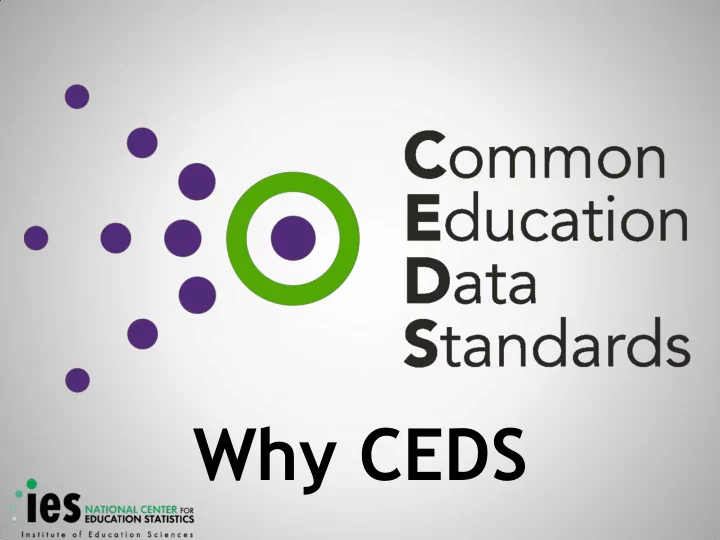

Why CEDS
Imagine… A high school student in one state enrolls in a university in another state that uses a different education data standard. 2
The Challenge • The two schools use different standards . • The university registrar cannot transfer the student’s transcript information with accuracy. 3
Imagine… A child is enrolled in both Early Intervention and Early Head Start, but the data standard is different for each program and provider agency. 4
The Challenge The regions or states looking to identify the level of access to services are not able to articulate an unduplicated count across programs of high-need children being served in each program. 5
Imagine… A community college system wants to compare the percent of community college students taking distance learning courses in their state to the percent of community college students taking distance learning courses in surrounding states. 6
The Challenge Without a common education data standard for distance learning courses, the resulting analysis would likely be flawed since each state could be defining "taking,” “distance learning course,” and "community college students” differently. 7
Lack of clear and consistent data standards can result in serious data complications. If data stakeholders had been speaking a common vocabulary , they could communicate the data with confidence in its accuracy and usefulness . 8
CEDS Solution This is why a common vocabulary — such as Common Education Data Standards — is essential. A common vocabulary allows stakeholders to avoid the confusion inherent in such situations. 9
CEDS 101
What is CEDS? A vocabulary including standard definitions, option sets, & technical specifications to streamline sharing and comparing A national collaborative effort to develop voluntary , common data standards for a key set of education data elements Voluntary Common Vocabulary 11
Reasons for a Common Vocabulary 1.Accurate, timely, and consistent data to inform decisionmaking 2.Share & compare high quality data within & across P-20 sectors 3.Decrease the staff burden associated with deciphering data 12
Why CEDS? Using consistent and comparable data throughout all education levels and sectors … … stakeholders, administrators, legislators, and researchers can more efficiently work together toward ensuring student success. 13
The Use of CEDS Use of CEDS allow different parties Administrators • Teachers • District- and state-level data stewards • to communicate about data that they all understand. 14
Growing with CEDS
Growing Users As standards expand and tools continue to be developed, benefits for stakeholders has grown beyond SEAs… LEAs, IHEs, early learning providers, vendors, researchers, and others have begun using CEDS. 16
Using CEDS INSTITUTIONS OF HIGHER EDUCATION • Adopting the standards in the development of metrics to respond to various policy initiatives aimed at improving postsecondary graduation rates. Example: Complete College America 17
Using CEDS EARLY LEARNING AGENCIES Using CEDS to develop an early learning • data system or to add early learning to the existing SLDS in the SEA. 18
Using CEDS VENDORS • Work to meet the needs of expanding and more complicated data systems in districts and states. • Many choose to incorporate the standards into their new products. 19
Using CEDS RESEARCHERS Using CEDS to accurately compare • data among different educational entities. 20
Using CEDS FEDERAL AGENCIES • Looking towards the incorporation of CEDS into their data collections to improve quality and accuracy of their data align different federal collections reduce data burden 21
CEDS Tools
CEDS ¡Tools ¡ • A Robust & Expanding Common, Voluntary Vocabulary drawn from existing sources • Powerful Stakeholder Tools & Models • Connect • Logical Data Model • Align • myConnect Why ¡CEDS ¡ Common ¡Educat i on ¡Data ¡Standards ¡ 23 ¡ http://ceds.ed.gov/
Align ¡ Web-based tool that allows users to • Import or input their data dictionaries • Align their current data to CEDS • Compare themselves with others • Analyze their data in relation to various other CEDS-aligned efforts Why ¡CEDS ¡ Common ¡Educat i on ¡Data ¡Standards ¡ 24 ¡ http://ceds.ed.gov/
Connect ¡ • Allows stakeholders to connect specific and relevant maps to a growing pool of CEDS Connections Stakeholders from varied types of educational organizations can use the tool to answer policy questions § § calculate metrics and indicators § address reporting requirements ¡ Why ¡CEDS ¡ Common ¡Educat i on ¡Data ¡Standards ¡ 25 ¡ http://ceds.ed.gov/
myConnect ¡ • Allows users to see the data elements in a published Connection side by side with their own data elements Why ¡CEDS ¡ Common ¡Educat i on ¡Data ¡Standards ¡ 26 ¡ http://ceds.ed.gov/
Engage with CEDS http://ceds.ed.gov
Recommend
More recommend